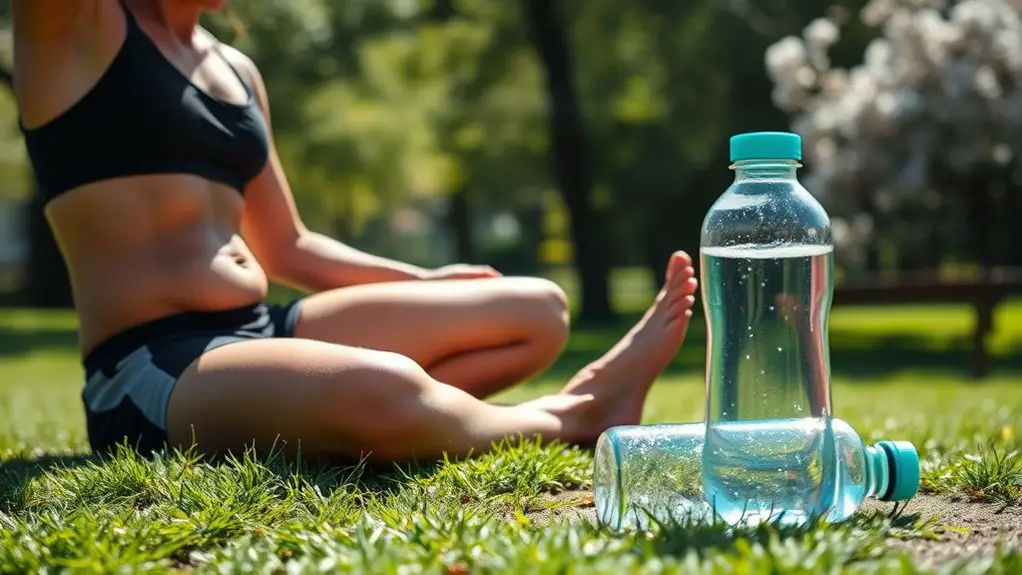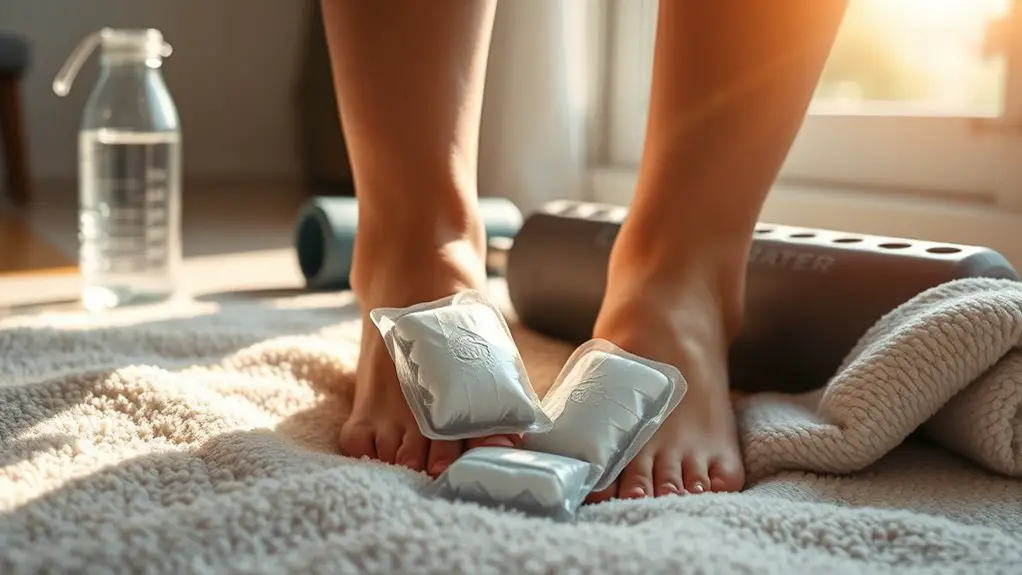To properly cool down after a workout, gradually decrease your intensity by slowing your pace instead of stopping abruptly. Incorporate light movements like walking and focus on deep, steady breaths. Follow up with stretching techniques—start with dynamic stretches, then switch to static ones for tight areas. Don't forget to hydrate, replenishing lost fluids and electrolytes. This process will help your body recover and set the stage for better performance in future workouts. There's so much more to explore about optimizing your routine!
The Importance of Cooling Down
Cooling down after a workout is essential, especially since it helps your body shift from high intensity back to its normal state. When you take the time to cool down, you're giving your muscles a chance to relax, which can prevent stiffness and soreness later. Plus, it helps regulate your heart rate and breathing, making you feel more in control of your body. This moment of freedom allows you to reflect on your achievements and prepare for what's next. It's not just about finishing strong; it's about honoring your body and its needs. So, don't skip this important step. Embrace the cool-down as a crucial part of your routine, giving yourself the freedom to recover and thrive.
Gradually Decrease Intensity
After you've taken the time to acknowledge your body's needs, it's important to gradually decrease intensity as you cool down. This step helps your body adjust smoothly back to a resting state. Here are three effective ways to do this:
Gradually decreasing intensity during cooldown is essential for a smooth transition back to rest.
- Slow Your Pace: If you've been running or cycling, slow down gradually instead of stopping abruptly. This helps your heart rate return to normal.
- Incorporate Light Movements: Shift to walking or gentle movements that keep your muscles engaged without strain, allowing for a natural deceleration.
- Mindful Breathing: Focus on deep, steady breaths as you lower your intensity, enhancing relaxation and signaling your body to unwind.
Stretching Techniques for Recovery
While you might be keen to jump back into your routine, incorporating stretching techniques after a workout is essential for recovery. Stretching helps release tension in your muscles and improves flexibility, allowing you to move freely. Start with dynamic stretches like arm circles and leg swings to loosen up. Then, shift to static stretches such as hamstring and quadriceps stretches, holding each for 15-30 seconds. Focus on areas that feel tight or sore. Don't rush; this is your time to unwind and connect with your body. Remember, stretching isn't just about preventing injuries; it's your way to enhance performance and enjoy the freedom of movement in your next workout. So take a moment, breathe, and stretch it out!
Breathing Exercises to Relax
To effectively shift from high energy to a calm state, incorporating breathing exercises can be incredibly beneficial. These exercises help you regain focus and promote relaxation, giving you the freedom to unwind fully after your workout. Here are three simple techniques to try:Incorporating breathing exercises can help you transition from high energy to a calm state, promoting relaxation and focus after your workout.
- Diaphragmatic Breathing: Inhale deeply through your nose, allowing your belly to expand, then exhale slowly through your mouth. Repeat for several minutes.
- Box Breathing: Inhale for a count of four, hold for four, exhale for four, and pause for four. This rhythmic pattern helps center your mind.
- 4-7-8 Breathing: Breathe in for a count of four, hold for seven, and exhale for eight. This technique can quickly calm your nervous system.
Integrating these exercises will leave you feeling refreshed and free.
Hydration After Workout
Proper hydration is essential for recovery once you've finished your workout, as it helps replenish lost fluids and supports muscle repair. When you sweat, you lose not just water but also electrolytes, which are crucial for muscle function. So, grab a invigorating drink—water is great, but consider adding an electrolyte-rich option if you've had an intense session. Listen to your body; it knows what it needs. Don't wait until you're thirsty—hydrate consistently post-workout. Aim for at least half your body weight in ounces of water daily to keep your energy levels high. Remember, staying hydrated isn't just about recovery; it's about feeling free and vibrant as you take on the day ahead. Cheers to your health!
Foam Rolling for Muscle Relief
Foam rolling can be a game changer for muscle relief after a workout. It helps release tension and improve blood flow, making you feel more relaxed and free. To get the most out of your foam rolling routine, consider these three tips:
- Target Tight Areas: Focus on muscle groups that feel tight or sore, like your quads, hamstrings, or back.
- Use Proper Technique: Roll slowly over each muscle group, pausing on tender spots for 20-30 seconds to maximize relief.
- Incorporate It Regularly: Make foam rolling a part of your post-workout ritual to enhance recovery and prevent stiffness.
Creating a Post-Workout Routine
While you might feel tempted to skip a post-workout routine, establishing one can greatly enhance your recovery and overall performance. Start with a few minutes of light stretching to ease tight muscles and improve flexibility. Focus on areas you worked during your session. Next, hydrate! Water helps flush out toxins and replenish lost fluids. Consider a healthy snack packed with protein and carbs to refuel your energy stores. If you enjoy journaling, take a moment to note how you felt during your workout; it helps track progress and keeps you motivated. Finally, don't forget to unwind mentally. Take a few deep breaths or practice mindfulness to help shift from your workout to your day. Embrace this routine—your body will thank you!
Frequently Asked Questions
How Long Should a Proper Cool Down Last?
Think of your body like a car; it needs a gentle slowdown after a race. A proper cool down should last about 5 to 10 minutes, letting your muscles relax and your heart find its rhythm.
Is Cooling Down Necessary for All Workout Types?
Cooling down isn't strictly necessary for every workout type, but it's beneficial. It helps your body shift smoothly, reduces injury risk, and promotes relaxation. You'll feel better overall when you take those extra moments.
Can I Skip Cooling Down if I'm Short on Time?
Sure, you can skip cooling down if you're pressed for time, but it might lead to stiffness or soreness later. Prioritizing a few minutes can make a big difference in your recovery and overall performance.
What Are Signs of Inadequate Cooling Down?
You might think skipping cooling down is fine, but inadequate cooling can lead to dizziness, muscle stiffness, and increased soreness. Listen to your body—those signs mean it's time to prioritize recovery and restore balance.
Does Cooling Down Help With Muscle Soreness?
Cooling down can definitely help with muscle soreness. It reduces lactic acid buildup, promotes blood flow, and aids recovery. So, when you take that time to cool down, you're giving your body a chance to heal.




